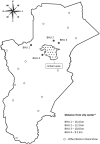Improving Access to the Glycated Hemoglobin Test in Rural Communities With Point-of-Care Devices: An Application Study
- PMID: 34881257
- PMCID: PMC8645789
- DOI: 10.3389/fmed.2021.734306
Improving Access to the Glycated Hemoglobin Test in Rural Communities With Point-of-Care Devices: An Application Study
Abstract
Background: Living in a rural or remote area is frequently associated with impaired access to health services, which directly affects the possibility of early diagnosis and appropriate monitoring of diseases, mainly non-communicable ones, because of their asymptomatic onset and evolution. Point-of-care devices have emerged as useful technologies for improving access to several laboratory tests closely patients' beds or homes, which makes it possible to eliminate the distance barrier. Objective: To evaluate the application of point-of-care technology for glycated hemoglobin (HbA1c) estimation in the assessment of glycemic control and identification of new diagnoses of diabetes in primary care among rural communities in a Brazilian municipality. Materials and Methods: We included individuals aged 18 years or older among rural communities in a Brazilian municipality. From September 2019 to February 2020, participants were assessed for anthropometrics, blood pressure, and capillary glycemia during routine primary care team activities at health fairs and in patient groups. Participants previously diagnosed with diabetes but without recent HbA1c test results or those without a previous diagnosis but with random capillary glycemia higher than 140 mg/dL were considered positive and were tested for HbA1c by using a point-of-care device. Results: At the end of the study, 913 individuals were accessed. Of these, 600 (65.7%) had no previous diagnosis of diabetes, 58/600 (9.7%) refused capillary glycemia screening and 542/600 (90.7%) were tested. Among tested individuals, 73/542 (13.5%) cases without a previous diagnosis of diabetes, were positive for capillary glycemia. Among positives, 31/73 (42.5%) had HbA1c levels that were considered indicative of prediabetes and 16/73 (21.9%) were newly diagnosed with diabetes. Among the participants, 313/913 (34.3%) were previously diagnosed with diabetes. Recent HbA1c results were unavailable for 210/313 (67.1%). These individuals were tested using point-of-care devices. Among them, 143/210 (68.1%) had HbA1c levels higher than target levels (>7% and >8% for adults and elderly individuals, respectively. Conclusion: The application of point-of-care devices for HbA1c level measurement improved the access to this test for people living in rural or remote areas. Thus, it was possible to include this technology in the routine activities of primary health care teams, which increased the rates of new diagnoses and identification of patients with uncontrolled glycemia.
Keywords: diabetes mellitus; glycated hemoglobin A; point-of-care testing; primary health care; rural communities.
Copyright © 2021 Camargo, Passos, Mistro, Soares, Kochergin, Carvalho, Macedo, Cortes, Souza, Rumel and Oliveira.
Conflict of interest statement
The authors declare that the research was conducted in the absence of any commercial or financial relationships that could be construed as a potential conflict of interest.
Figures
References
-
- Saeedi P, Petersohn I, Salpea P, Malanda B, Karuranga S, Unwin N. Global and regional diabetes prevalence estimates for 2019 and projections for 2030 and 2045: results from the international diabetes federation diabetes atlas, 9th edition. Diabetes Res Clin Pract. (2019) 157:107843. 10.1016/j.diabres.2019.107843 - DOI - PubMed
LinkOut - more resources
Full Text Sources



